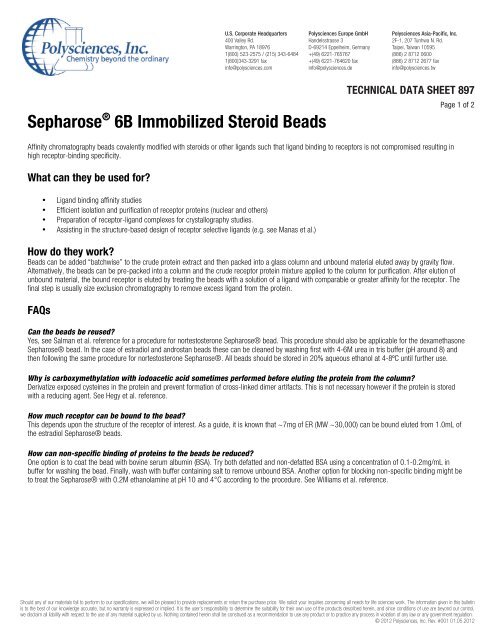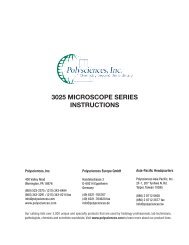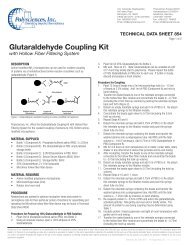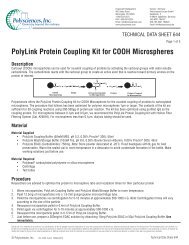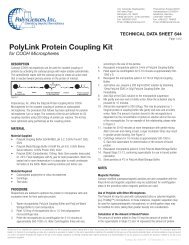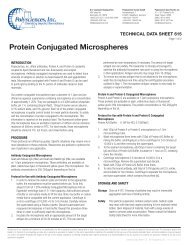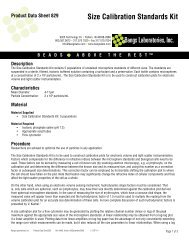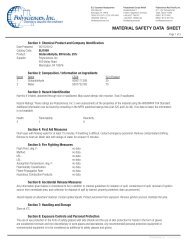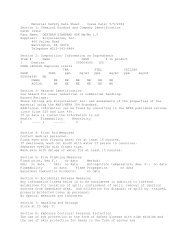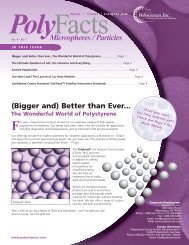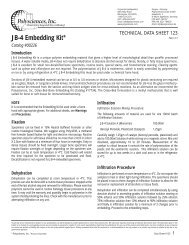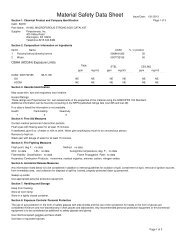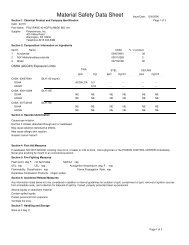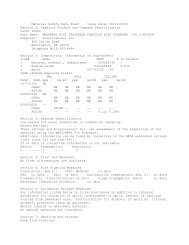Sepharose® 6B Immobilized Steroid Beads - Polysciences, Inc.
Sepharose® 6B Immobilized Steroid Beads - Polysciences, Inc.
Sepharose® 6B Immobilized Steroid Beads - Polysciences, Inc.
You also want an ePaper? Increase the reach of your titles
YUMPU automatically turns print PDFs into web optimized ePapers that Google loves.
U.S. Corporate Headquarters<br />
400 Valley Rd.<br />
Warrington, PA 18976<br />
1(800) 523-2575 / (215) 343-6484<br />
1(800)343-3291 fax<br />
info@polysciences.com<br />
Sepharose ® <strong>6B</strong> <strong>Immobilized</strong> <strong>Steroid</strong> <strong>Beads</strong><br />
<strong>Polysciences</strong> Europe GmbH<br />
Handelsstrasse 3<br />
D-69214 Eppelheim, Germany<br />
+(49) 6221-765767<br />
+(49) 6221-764620 fax<br />
info@polysciences.de<br />
<strong>Polysciences</strong> Asia-Pacific, <strong>Inc</strong>.<br />
2F-1, 207 Tunhwa N. Rd.<br />
Taipei, Taiwan 10595<br />
(886) 2 8712 0600<br />
(886) 2 8712 2677 fax<br />
info@polysciences.tw<br />
TECHNICAL DATA SHEET 897<br />
Affinity chromatography beads covalently modified with steroids or other ligands such that ligand binding to receptors is not compromised resulting in<br />
high receptor-binding specificity.<br />
What can they be used for?<br />
• Ligand binding affinity studies<br />
• Efficient isolation and purification of receptor proteins (nuclear and others)<br />
• Preparation of receptor-ligand complexes for crystallography studies.<br />
• Assisting in the structure-based design of receptor selective ligands (e.g. see Manas et al.)<br />
How do they work?<br />
<strong>Beads</strong> can be added “batchwise” to the crude protein extract and then packed into a glass column and unbound material eluted away by gravity flow.<br />
Alternatively, the beads can be pre-packed into a column and the crude receptor protein mixture applied to the column for purification. After elution of<br />
unbound material, the bound receptor is eluted by treating the beads with a solution of a ligand with comparable or greater affinity for the receptor. The<br />
final step is usually size exclusion chromatography to remove excess ligand from the protein.<br />
FAQs<br />
Page 1 of 2<br />
Can the beads be reused?<br />
Yes, see Salman et al. reference for a procedure for nortestosterone Sepharose® bead. This procedure should also be applicable for the dexamethasone<br />
Sepharose® bead. In the case of estradiol and androstan beads these can be cleaned by washing first with 4-6M urea in tris buffer (pH around 8) and<br />
then following the same procedure for nortestosterone Sepharose®. All beads should be stored in 20% aqueous ethanol at 4-8ºC until further use.<br />
Why is carboxymethylation with iodoacetic acid sometimes performed before eluting the protein from the column?<br />
Derivatize exposed cysteines in the protein and prevent formation of cross-linked dimer artifacts. This is not necessary however if the protein is stored<br />
with a reducing agent. See Hegy et al. reference.<br />
How much receptor can be bound to the bead?<br />
This depends upon the structure of the receptor of interest. As a guide, it is known that ~7mg of ER (MW ~30,000) can be bound eluted from 1.0mL of<br />
the estradiol Sepharose® beads.<br />
How can non-specific binding of proteins to the beads be reduced?<br />
One option is to coat the bead with bovine serum albumin (BSA). Try both defatted and non-defatted BSA using a concentration of 0.1-0.2mg/mL in<br />
buffer for washing the bead. Finally, wash with buffer containing salt to remove unbound BSA. Another option for blocking non-specific binding might be<br />
to treat the Sepharose® with 0.2M ethanolamine at pH 10 and 4°C according to the procedure. See Williams et al. reference.<br />
<br />
Should any of our materials fail to perform to our specifications, we will be pleased to provide replacements or return the purchase price. We solicit your inquiries concerning all needs for life sciences work. The information given in this bulletin<br />
is to the best of our knowledge accurate, but no warranty is expressed or implied. It is the user’s responsibility to determine the suitability for their own use of the products described herein, and since conditions of use are beyond our control,<br />
we disclaim all liability with respect to the use of any material supplied by us. Nothing contained herein shall be construed as a recommendation to use any product or to practice any process in violation of any law or any government regulation.<br />
© 2012 <strong>Polysciences</strong>, <strong>Inc</strong>. Rev. #001 01.05.2012
#897 Sepharose ® <strong>6B</strong> <strong>Immobilized</strong> <strong>Steroid</strong> <strong>Beads</strong><br />
TECHNICAL DATA SHEET 897<br />
Page 2 of 2<br />
Ordering Info<br />
Cat. # Product Typical ligand loading<br />
24858 Androstan® <strong>6B</strong> 10-14 µmoles/mL bead<br />
24859 Dexamethasone Sepharose® <strong>6B</strong> 10-14 µmoles/mL bead<br />
24861 Estradiol Sepharose® <strong>6B</strong> 10-14 µmoles/mL bead<br />
24860 Nortestosterone Sepharose® <strong>6B</strong> 10-14µmoles/mL bead<br />
24869 Long Spacer Arm Dexamethasone Sepharose® <strong>6B</strong> 10-14 µmoles/mL bead<br />
24868 RHC-80267 (U-57908) Sepharose® <strong>6B</strong> 12-15 µmoles/mL bead<br />
References:<br />
Manas ES et al. Structure-based Design of Estrogen Receptor-Beta Selective Ligands. J. Am. Chem. Soc., 126, 15106-15119 (2004).<br />
Salman M et al. A Progesterone Receptor Affinity Chromatography Reagent: 17α-Hexynyl Nortestosterone Sepharose. J. <strong>Steroid</strong> Biochem., 26,<br />
3, 383-391(1987).<br />
Williams AJK et al. Non-specific binding to protein A Sepharose and protein G Sepharose in insulin autoantibody assays may be reduced by pre-treatment<br />
with glycine or ethanolamine. J. Immunol. Methods, 314:170-173 (2006).<br />
Hegy GB et al. Carboxymethylation of the human estrogen receptor ligand-binding domain-estradiol complex: HPLC/ESMS peptide mapping shows that<br />
cysteine 447 does not react with iodoacetic acid. <strong>Steroid</strong>s, 61:367-373 (1996).<br />
Sold under license from PTI Research, <strong>Inc</strong>. to MTTI and distributed by <strong>Polysciences</strong>, <strong>Inc</strong>. Sepharose is a trademark of GE Healthcare.<br />
North America (United States)<br />
1 (800) 523-2575 / (215) 343-6484<br />
1 (800) 343-3291 / (215) 343-0214 fax<br />
Europe (Germany)<br />
(49) 6221-765767 / (49) 6221-764620 fax<br />
Asia-Pacific (Taiwan)<br />
(886) 2 8712 0600 / (886) 2 8712 2677 fax<br />
Online anytime at: polysciences.com<br />
Should any of our materials fail to perform to our specifications, we will be pleased to provide replacements or return the purchase price. We solicit your inquiries concerning all needs for life sciences work. The information given in this bulletin<br />
is to the best of our knowledge accurate, but no warranty is expressed or implied. It is the user’s responsibility to determine the suitability for their own use of the products described herein, and since conditions of use are beyond our control,<br />
we disclaim all liability with respect to the use of any material supplied by us. Nothing contained herein shall be construed as a recommendation to use any product or to practice any process in violation of any law or any government regulation.<br />
© 2012 <strong>Polysciences</strong>, <strong>Inc</strong>. Rev. #001 01.05.2012


